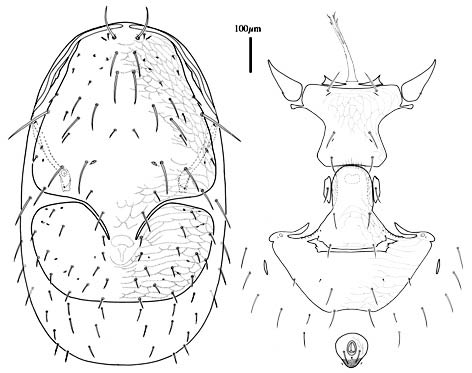Moustache-like internal malae
Scale above 3-tined palp apotele
Separate or deeply incised dorsal shields
Anal shield free from ventral shield.
Home | Mesostigmata (Monogynaspida) Home | Glossary
Veigaia
Taxonomic Position
Cohort Gamasina
Subcohort Dermanyssiae
Family: Veigaiidae Oudemans
Veigaia Oudemans
Diagnostic characters: M
Moustache-like internal malae
Scale above 3-tined palp apotele
Separate or deeply incised dorsal shields
Anal shield free from ventral shield.
Similar taxa. Parasitidae are superficially similar, but have ventrianal shields and lack characters such as the scale-like process above the palp apotele and moustache-like internal malae.
Diagnosis. Yellow to orange-brown dermanyssine mesostigmatans. Females with separate podonotal and opisthonotal shields or with deeply incised schizodorsal shield; opisthonotal region reduced, hypotrichous to slightly hypertrichous; males with holodorsal shield. Peritremes typical running past coxa I; peritrematal shield usually narrow, joining podonotal shield anteriorly, sometimes fused to ventral shield. Female with large sternal shield bearing 3 pairs of setae (st1-3) and 2 pairs of lyrifissures (stp1-2); metasternal shields strap-like to subtriangular and bearing st4, stp3; genital shield usually trapezoid and bearing 1 pair of setae, free from, partially fused to (at posterior corners), or completely fused to ventral shield; rarely absent (Gamasolaelaps); ventral shield well developed, free from or fused to peritrematal or genital shields; anal shield free and bearing 3 circumanal setae, rarely with 1 pair of ventral setae. Tarsus I slender, elongate, with claws; trochanter I with 6 setae; tibia I with 6 dorsal and 4 (rarely 3) ventral setae; genu IV with 5 dorsal and 2 ventral setae; trochanter and femur IV of female sometimes with ventral spurs. Chelicerae typically elongate, snapping, with teeth and blade-like regions, less commonly chelate-dentate; movable digit without excrescences. Palp genu with 6 setae, palp apotele 3-4 tined and with dorsal hyaline scale-like process; corniculi horn-like; internal malae highly divided, often bilobed and moustache-like. Tritosternum biflagellate, with columnar base. Tectum bifurcate, and often with an elongate, subdorsal median process; subcapitular gutter usually broad, with 10 rows of denticles. Female sperm induction pores typically near base of coxae IV; sperm ducts lead to unpaired, central spermathecal sack (laelapid type). Males with genital opening at base of tritosternum in sternogenital shield or holoventral plate; spermatodactyl simple and finger-like to extremely elongate; legs II with spurs on femora, genua, tibiae and tarsi.
Key to Genera of Veigaiidae
1. Tarsi II-IV with 1-2 broad ambulacral pads.................................................................... 2
- Tarsi II-IV with 2 narrow, acuminate ambulacra....................... Cyrthydrolaelaps Berlese
2. Ambulacral pad entire.................................................................. Gamasolaelaps Berlese
- Ambulacra divided into 2 lobes........................................................... Veigaia Oudemans
References
Evans GO. 1959. The genera Cyrthydrolaelaps Berlese and Gamasolaelaps Berlese (Acarina: Mesostigmata). Acarologia 1:201-215.
Farrier MH. 1957. A revision of the Veigaiidae (Acarina). North Carolina Agricultural Experiment Station Technical Bulletin 124: 1-103.
Gilyarov MS & Bregatova NG (eds) 1977. Handbook for the Identification of Soil-inhabiting Mites, Mesostigmata. Zoological Institute of the Academy of Sciences: Petrograd [In Russian]
Halliday RB. 1990. The occurrence of Veigaia uncata Farrier (Acarina : Mesostigmata : Veigaiidae) in Australia and Papua New Guinea. Australian Entomological Magazine 17: 115-116.
Hurlbutt HW. 1983. The systematics and geographic distribution of east African Veigaiidae (Acarina: Mesostigmata). Acarologia 24(2): 129-143.
Hurlbutt HW. 1984. A study of North American Veigaia (Acarina: Mesostigmata) with comparisons of habitats of unisexual and bisexual forms. Acarologia 25: 207-222.
Ishikawa K. 1978. The Japanese mites of the family Veigaiidae (Acari, Mesostigmata). 1. Description of two new species. Annotationes Zoologicae Japonenses 51(2): 100-106.
Till, WM: 1988. Additions to the British and Irish mites of the genus Veigaia (Acari: Veigaiidae) with a key to the species. Acarologia 29(1): 3-12
Tseng, Yi Hsiung. 1994. A taxonomic study of free living Gamasinae mite family Veigaiidae Oudemans (Acari: Mesostigmata) from Taiwan. Chinese Journal of Entomology 14(4): 501-528
Womersley, H. 1956. On some new Acarina-Mesostigmata from Australia, New Zealand and New Guinea. Journal of the Linnean Society (Zoology) 42: 505-599.